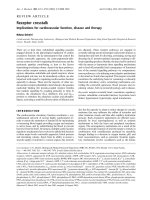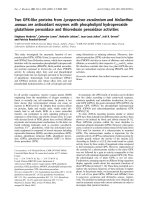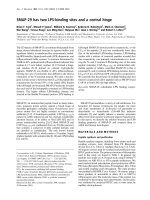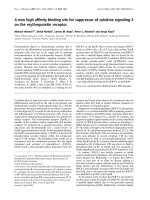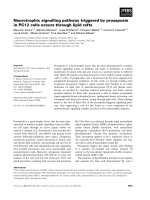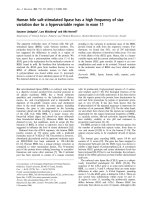Báo cáo y học: "Portal hypertensive enteropathy diagnosed by capsule endoscopy and demonstration of the ileal changes after transjugular intrahepatic portosystemic shunt placement: a case report" docx
Bạn đang xem bản rút gọn của tài liệu. Xem và tải ngay bản đầy đủ của tài liệu tại đây (1016.04 KB, 4 trang )
CAS E REP O R T Open Access
Portal hypertensive enteropathy diagnosed by
capsule endoscopy and demonstration of the
ileal changes after transjugular intrahepatic
portosystemic shunt placement: a case report
Alessandro Pezzoli
*
, Nadia Fusetti, Loredana Simone, Angelo Zelante, Viviana Cifalà, Alessandra Carella,
Sergio Gullini
Abstract
Introduction: Recent data suggest that mucosal abnormalities can occur even in the duodenum, jejunum, and
distal ileum of cirrhosis patients. We present a case of portal hypertensive enteropathy in a cirrhosis patient shown
by capsule endoscopy and the effect of transjugular intrahepatic portosystemic shunt on the ileal pictures.
Case presentation: An 83-year-old Caucasian woman was admitted to our hospital for anemia and a positive fecal
occult blood test. An upper gastrointestinal endoscopy revealed small varices without bleeding signs and
hypertensive gastropathy. Colonoscopy was negative. To rule out any other cause of bleeding, capsule endoscopy
was performed; capsule endoscopy revealed severe hyperemia of the jejunum-ileal mucosa with active bleeding.
Because of the persistence of anemia and the frequent blood transfusions, not responding to b-blocker drugs or
octreotide in fusion, a transjugular intrahepatic portosystemic shunt was performed. Anemia improved quickly after
the transjugular intrahepatic portosystemic shunt, and no further blood transfusion was necessary in the follow-up.
The patient developed portal encephalopathy two months later and was readmitted to our department. We
repeated the capsule endoscopy that showed a significant improvement of the gastric and ileal mucosa without
any signs of bleeding.
Conclusion: Hypertensive enteropathy is a rare condition, but it seems more common with the introduction of
capsule endoscopy in clinical practice. This case shows that the jejunum can be a source of bleeding in cirrhosis
patients, and this is the first demonstration of its resolution after transjugular intrahepatic portosystemic shunt
placement.
Introduction
Changesinthegastricmucosaareawell-knownaspect
ofcirrhosisinpatientswith portal hypertension [1].
Some data suggest that similar abnormalities can also
occur in the duodenum, jejunum, and distal ileum [2-4].
With the introduction of capsule endoscopy (CE) in
clinical practice, these changes can be detected easily,
and t he so-called “portal hypertensive enteropathy” [5]
seems more common [6-9]. We present a case of portal
hypertensive enteropathy (PHE) in a cirrhosis patient
shown by CE and the effect of transjugular intrahepatic
portosystemic shunt (TIPS) placement on the ileal
pictures.
Case presentation
An 83-year-old Caucasian w oman with cirrhosis was
admitted several times to our hospital for anemia and
positive fecal occult blood tests. The medical history
included cirrhosis-related hepatitis C virus (HCV) diag-
nosed 18 years ago and a recent diagnosis of atrial flut-
ter/fibrillation treated only with b-blockers drugs
(neither anticoagula nt nor antiplatelet therapy was pre-
scribed because of the anemia). Four years ago, she pre-
sented with ascites that was treated with paracentesis
* Correspondence:
Department of Gastroenterology and GI Endoscopy, Arcispedale S.Anna,
Corso Giovecca 203, 44100 Ferrara, Italy
Pezzoli et al. Journal of Medical Case Reports 2011, 5:90
/>JOURNAL OF MEDICAL
CASE REPORTS
© 2011 Pezzoli et al; licensee BioMed Central Ltd. This is an Open Access article distributed under the terms of the Creative Commons
Attribution License ( .0), which permits unrestricted use, di stribution, and reproduction in
any medium, provided the original work is pro perly cited.
and diuretic drugs. No other episodes of a scites were
reported in the follow-up, but anemia was constantly
present, and the patient underwent multiple blood
transfusions. In two years, upper gastrointestinal (GI)
endoscopy was performed three times, and this revealed
esophageal varices (F2, according to NIEC classification
[10]) without signs of bleeding. There was severe hyper-
tensive gastropathy, but active bleeding or clots in the
stomach were never observed. Colonoscopy was nega-
tive. We started therapy with b-blockers (40 mg/day at
maximum dosage because of hypotension) first, and
later with octreotide, without any significant eff ect on
the anemia (mean hemoglobin level, 6 to 7 g/dl). To
rul e out any other cause of anemia, we performed a CE
that showed severe portal hypertensive gastropathy
(Figure 1) and diffuse erythema of the jejunum mucosa
with melena and active oozing bleeding (Figure 2).
Because of the persistent anemia that required frequent
blood transfusions, we decided on a TIPS placement.
During the procedure, the portosystemic pressure gradi-
ent was measured, showing a value of 13 mm Hg, After
the TIPS, no other anemia or bleeding episodes were
observed in the follow-up, and the hemoglobin level
increased to 9 to 10 g/dl. Two months later, the patient
was readmitted to our hospital for portal encephalopa-
thy and jaundice. The initial laboratory results revealed
the following: hemoglobin, 9.5 g/dl; hematocrit, 31%;
serum urea nitrogen, 42 mmol/L; PT, 2.2INR; PLT.
70,000/mm
3
; bilirubin, 45 mg/dl (total, 30 mg/dl); blood
ammonia level, 125 mg/dl.
We started therapy with lactulose, antibiotics, and
fluids; moreover, we repeated the CE, which showed a
dramatic improvement in the gastric (Figure 3) and
jejunal picture without evidence of bleeding (Figure 4).
The patient died 15 days later of liver failure, but the
hemoglobin level remained stable for that time.
Figure 1 Portal hypertensive gastropathy: severe portal
hypertensive gastropathy with minimal oozing.
Figure 2 Portal hypertensive enteropathy. Black stools in the
jejunum with areas of spontaneous active bleeding.
Figure 3 Gastric pictures after transjugular intrahepatic
portosystemic shunt (TIPS) placement. Mosaic pattern of the
antrum without any bleeding signs.
Pezzoli et al. Journal of Medical Case Reports 2011, 5:90
/>Page 2 of 4
Discussion
In this case report, we describe the changes that occurred
in the gastric and jejunal mucosa in a cirrhosis patient
with portal hypertension with CE, and we report the
positive effect of a TIPS placement. The clinical value
and prevalence of PHE are not well known, but with the
advent of CE, this entity seems more common, and some
authors report a prevalence of more than 60% [6-9].
These data c onfirm that the hemodynamic alteration
of portal hypertension can produce relevant effects in
the small bowel mucosa, similar to t hose found in the
gastric mucosa.
De Palma et al. [6] and Goulas et al. [7] observed that
the frequency of the PHE increases with w orsening of
Child-Pugh clas s, but other authors have not found this
correlation [8,9]. Moreover, active ileal bleeding has
been observed in 5% to 10% of cirrhosis patients [6,9].
Our patient had anemia as the main symptom; she had
severe portal hypertension, although no variceal bleeding
was observed, and the global liver function was satisfac-
tory. In our patient, the anemia was due both to portal
hypertensive gastropathy and to active bleeding observed
in the jejunum by CE. The correlation between portal
hypertensive gastropathy and PHE was also observed in
a previous study [7].
A multicenter study, published in abstract form,
reported the results of CE in cirrhosis patients with
unexplained bleeding [11], stres sing the use fulness of
CE results in the management o f patients with portal
hypertension. Our patient was treated with b-blockers
and octreotide, without any significant effect. A number
of pharmacologic agents have been used in acute bleed-
ing due to portal hypertensive gastropathy; nonselective
b-blockers and octreotide have been found to be suc-
cessful in a high percentage of cases, whereas vasopres-
sin and omeprazole were not so effective. Few data are
available regarding the management of chronic bleeding,
and the use of b-blockers has shown minimal improve-
ment in such patients [12]. T he effect of drug therapy
on P HE was reported in anecdotal cases only. Surgical
shunt is another option in patients with severe portal
hypertension , but we did not consider it for this patient
because of the high operative risk and multiple co-mor-
bidities. In our case , the CE finding has prompted us to
consider TIPS placement to control bleedin g. TIPS is a
well-known technique to reduce portal hypertension
and to control variceal bleeding [13], but no data are
available about its effect on jejunal mucosa in cases of
PHE. The American Association for the Study of Liver
Disease (AASLD) suggests TIPS as the preferred
approach for prevention of recurrent bleeding in
patients with ectopic varices [14]. Our patient showed
an improvement of anemia after TIPS, and we were able
to show the beneficial effect of TIPS placement on
mucosal da mage. Unfortunately, the patient died about
three months later but we know that the one-year survi-
val after TIPS varies from 48% to 90%, according to the
severity of the liver disease [15]. Nonetheless, this case
shows that the decompression of the portal vein after
TIPS pla cement had a positive ef fect, not only on eso-
phageal varices and hypertensive gastropathy, but also
on the duodenal-jejunal mucosa. To our knowledge, this
is the first description of a significant improvement of
PHE after TIPS placement documented by CE.
Conclusions
CE has made it possible to examine the sm all bowel
mucosa directly and has allowed endoscopists to visua-
lize the mucosal changes in cirrhosis patients with por-
tal hypertension. This case underlines the fact that
hemodynamic alterations of portal hypertension can
produce relevant effects on the small-bowel mucosa.
Therefore, we must bear in mind that the jejunum can
also be a source of bleeding, and in cirrhosis patients
with unexplained anemia, CE should be considered to
optimize the treatment of portal hypertension.
Consent
Written informed consent was obtained from the next-
of-kin for publication of this manuscript and accompa-
nying images. A copy of the written consent is available
for review by the Editor-in-Chief of this journal
Figure 4 Small bowel mucosa after transjugular int rahepatic
portosystemic shunt (TIPS). Jejunal mucosa with minimal
cherry-red spots without any bleeding signs.
Pezzoli et al. Journal of Medical Case Reports 2011, 5:90
/>Page 3 of 4
Acknowledgements
We thank Ms Alison Milne for reviewing the English version of the
manuscript.
Authors’ contributions
AP made substantial contributions to the conception and drafting the
article. He performed the capsule endoscopy procedure. NF monitored the
patient during the admission periods. LS followed up the patient during the
admission periods. AZ performed the ultrasound examination of the patient
before and after TIPS placement. VC performed several upper GI
endoscopies in the patient. AC helped in analysis and interpretation of the
data. SG made suggestions in writing the manuscript and the final approval
of the article. All authors read and approved the final manuscript.
Competing interests
The authors declare that they have no competing interests.
Received: 5 March 2010 Accepted: 4 March 2011
Published: 4 March 2011
References
1. Baxter J, Dobbs B: Portal hypertensive gastropathy. J Gastroenterol Hepatol
1988, 3:635-644.
2. Nagral AS, Joshi AS, Bhatia SL, Abraham P, Mistry FP, Vora IM: Congestive
jejunopathy in portal hypertension. Gut 1993, 34:694-697.
3. Viggiano TR, Gostout CJ: Portal hypertensive vasculopathy: a review of
the clinical endoscopic and histophological features. Am J Gastroenterol
1992, 87:944-954.
4. Misra SP, Dwivedi M, Misra V, Gupta M: Ileal varices and portal
hypertensive ileopathy in patients with cirrhosis and portal
hypertension. Gastrointest Endosc 2004, 60:778-783.
5. Rondonotti E, Villa F, Signorelli C, De Franchis R: Portal hypertensive
enteropathy. Gastrointest Endosc Clin North Am 2006, 16:277-286.
6. De Palma G, Rega M, Masone S, Persico F, Siciliano S, Patrone F,
Matantuono , Persico G: Mucosal abnormalities of the small bowel in
patients with cirrhosis and portal hypertension: a capsule endoscopy
study. Gastrointest Endosc 2005, 62:529-534.
7. Goulas S, Triantafyllidou K, Karagiannis S, Nicolaou P, Galanis P, Vafiadis I,
Tzivras M, Mavrogiannis C: Capsule endoscopy in the investigation of
patients with portal hypertension and anaemia. Can J Gastroenterol 2008,
22:469-474.
8. Urbain D, Vandebosch S, Hindryckx P, Colle I, Reynaert H, Mana F, Vanden
Branden S, Van Vlierberghe H, De Vos M, De Looze D: Capsule endoscopy
findings in cirrhosis with portal hypertension: a prospective study. Dig
Liver Dis 2008, 40:391-393.
9. Figuereido P, Almeida N, Lèrias C, Lopes S, Gouveia H, Leitao MC, Freitas D:
Effect of portal hypertension in the small bowel: an endoscopic
approach. Dig Dis Sci 2008, 53:2144-2150.
10. North Italian Endoscopic Club for the Study and Treatment of Oesophageal
Varices: Prediction of the first variceal haemorrhage in patients with
cirrhosis of the liver and oesophageal varices: a prospective multicenter
study. N Engl J Med 1988, 319:983-989.
11. Jacob P, Favre O, Daudet J, Lapalus M, Ben Soussan E, Saurin J: Clinical
impact of capsule endoscopy for unexplained bleeding in cirrhosis,
results from 21 patients. Endoscopy 2005, 37(suppl I):A287.
12. Cubillas R, Rokey P: Portal hypertensive gastropathy: a review. Liver Int
2010, 30:1094-1102.
13. Luca A, D’Amico G, La Galla R, Mirini M, Morabito A, Pagliaro L: TIPS for
prevention of recurrent bleeding in patients with cirrhosis: meta-analysis
of randomized clinical trials. Radiology 1999, 212:411-421.
14. Boyer TD, Haskal ZJ: The role of transjugular intrahepatic portosystemic
shunts in the management of portal hypertension. Hepatology
2005,
41:386-399.
15. Malinchoc M, Kamath PS, Gordon FD, Peine CJ, Rank J, Borg PC: A model
to predict poor survival in patients undergoing transjugular intrahepatic
portosystemic shunts. Hepatology 2000, 31:864.
doi:10.1186/1752-1947-5-90
Cite this article as: Pezzoli et al.: Portal hypertensive enteropathy
diagnosed by capsule endoscopy and demonstration of the ileal
changes after transjugular intrahepatic portosystemic shunt placement:
a case report. Journal of Medical Case Reports 2011 5:90.
Submit your next manuscript to BioMed Central
and take full advantage of:
• Convenient online submission
• Thorough peer review
• No space constraints or color figure charges
• Immediate publication on acceptance
• Inclusion in PubMed, CAS, Scopus and Google Scholar
• Research which is freely available for redistribution
Submit your manuscript at
www.biomedcentral.com/submit
Pezzoli et al. Journal of Medical Case Reports 2011, 5:90
/>Page 4 of 4


